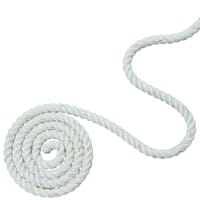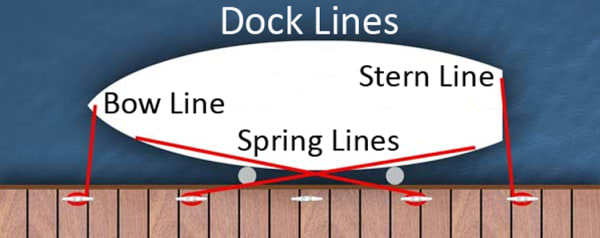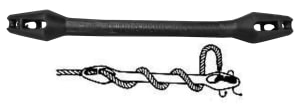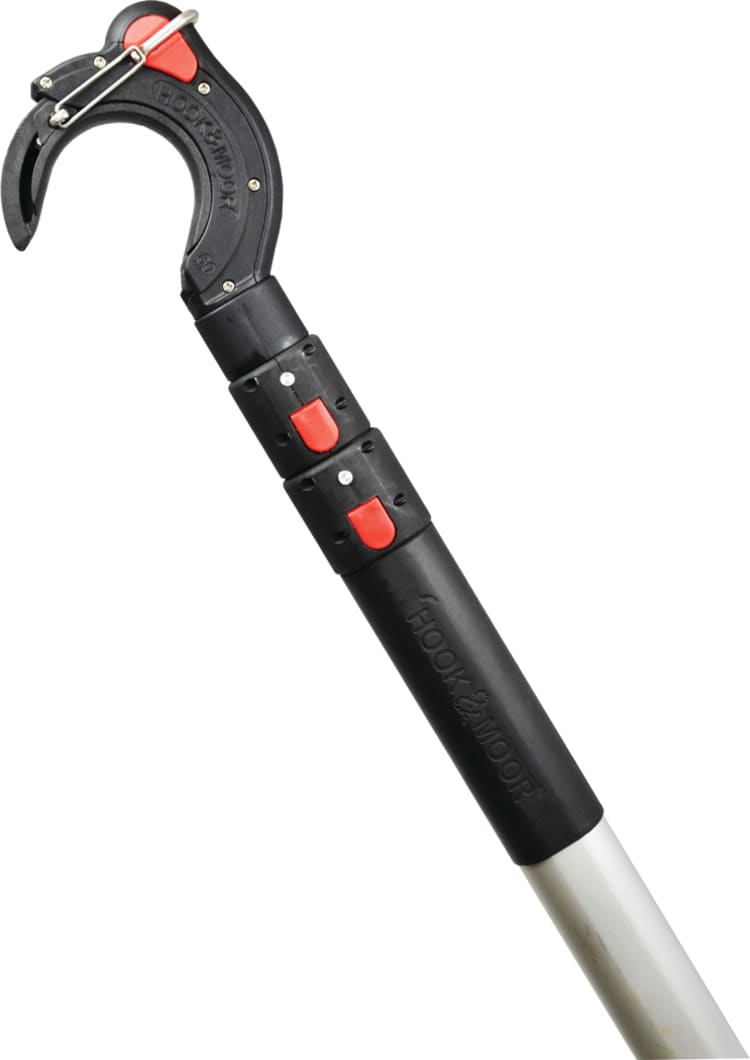Understanding Dock Lines

What Do I Need to Know About Dock Lines?
A dock line is what keeps your boat in place at the dock, so it needs to be strong and elastic (to absorb shock loads), as well as resistant to abrasion, UV rays, and rot. This makes nylon, which has a good combination of all these qualities, an ideal choice.
Material and Construction
High strength and the ability to stretch without breaking allow nylon dock lines to absorb shock loads when wind and waves cause your boat to buck and surge at the dock. With a less elastic line, those high shock loads would be transmitted to your deck cleats or other hardware, potentially causing damage to your boat or even allowing the line to snap and the boat to break free. Nylon's resistance to rot and mildew also means it can be stowed when wet, if necessary.

Fisheries Supply offers three main types of dock lines:
- 3-Strand Twisted Nylon, a simple 3-strand line with no cover
- Double Braid Nylon, where both the core and covering sheath are braided, rather than twisted.
- Mega Braid Nylon, where 12 sets of 3-strand line are constructed into one single braid.

3-strand twisted dock lines are economical and have a traditional look, while double braid nylon dock lines are softer, easier to handle, don't harden over time, and offer a certain aesthetic appeal. While a little more expensive, double braid dock lines can be 25% to 35% stronger than 3-strand line of the same diameter. Mega braid is a strong line that offers good handling, resists kinking and has excellent flexibility and UV protection. It is only meant for use on boats 40 foot or larger.
Types and Functions
Boats are typically “made fast” (i.e. tied to the dock) with a set of 4 dock lines. Since the location of mooring cleats and pilings will vary from dock to dock, it is usually prudent to have dock lines which are too long, rather than too short.
Bow and Stern Lines run from the ends of the boat to the dock, usually at an angle, keeping the boat from moving side to side, as well as fore and aft. They are typically equal to about three quarters of the boat's length.
Longer Spring Lines run forward from the stern and aft from the bow of the boat, or sometimes from amidships, to keep the boat from moving forward and backward along the dock. A boat should have two spring lines that are at least as long as the boat to keep it safely in place. The longer length provides extra stretch (or spring) for extra motion dampening.

If you look at the diagram, you can see that all four of your dock lines work together, stretching and relaxing, to keep the boat more or less in place, despite the action of wind or waves jostling the boat. It's perfectly okay - even good - for the boat to be able to move around a little – so make sure you don't cleat the lines off too tightly.
In those parts of the world which experience large tidal fluctuations, you may require longer dock lines when tied to stationary docks. Tying to a floating dock may allow the use of shorter lines.
Finally, short “Breast Lines” lead from the bow or stern directly to the dock, and may be used to temporarily hold a boat close to the dock for boarding or loading, but these should be removed or slackened when the boat is left unattended, leaving the longer bow, stern, and spring lines to keep the boat secure, yet still absorbing the forces of wind and waves.
Sizing
Dock lines should be strong enough to hold the boat and have enough bulk to resist chafe, while not being so heavy as to lose their shock-absorbing characteristics.
Choosing the diameter of your dock lines is not an exact science, and depends on many variables such as exposure to waves, wind, and currents, as well as vessel displacement and windage – all of which should to be taken into account. That said, for a “typical” boat under “typical” conditions, the table below can provide some guidance in choosing an appropriate size.
| Dock Line Diameter | Typical Boat Lengths |
| 3/8” (10 mm) |
Up to 20 ft |
| 1/2” (13 mm) | 20 ft – 32 ft |
| 5/8” (16 mm) | 33 ft – 48 ft |
| 3/4” (19 mm) | 49 ft – 65 ft |
Dock lines should be inspected regularly for signs of wear indicated by chafing damage, unraveling, or discoloration. They should be replaced before aging or wear become a liability.
In severe weather conditions, some people choose to use dock lines of a larger diameter, or even “double up” some of the lines. But notice that while making them stronger, this may decrease their cushioning effect, just when your dock and deck hardware need it the most. A better option may be to add additional dock lines secured to previously unused hardware and tie-off points. As always, good seamanship requires good judgment and analysis of every situation. Increased attention to dock line chafing gear is always prudent in severe weather.
Related Products

In addition to dock lines, it is also a good idea to add shock absorbers – called "snubbers" – to the lines that are under the highest load. Not only does this take some of the stress off your dock lines, it also can relieve the tension on your hardware. The shock absorber will stretch first – taking the brunt of the force – which helps your dock lines last longer.

If you have areas on your boat where dock lines seem to rub a little more vigorously than elsewhere, it's a good idea to add chafe protection. There are two options - you can either put the chafe gear directly over the dock line directly over the spot where you expect the most abrasion or you can add a smooth rub strake for the line to glide across. Chafe protection added directly to the line means the chafe guard will wear – not your dock line - while a rub strake is better when a line is passing over something like a like a corner or fiberglass edge and you need help getting the line to cross the area smoothly - protecting both your boat AND your dock line.
It's also critical that you have properly sized and installed boat cleats – preferably with a backing plate attached below deck. During storms or high winds, your cleats on deck can be under tremendoes pressure – so it's very important that you have the right size for your boat, and that it's been properly bedded with support from below so it doesn't just rip out under high load.

Lastly – it's often helpful to have a boat hook handy when docking to help grab the item you want to attach your dock line to. Modern boat hooks come in a variety of styles and lengths – something for pretty much any boat size. There are now some designs that can even pass the dock line directly through the cleat without you leaving the boat - so make sure to check out our selection!
We hope this has helped you learn the importance of protecting your investment with good gear at the dock. Fisheries Supply carries a variety of pre-spliced dock lines, but we also offer splicing services if you want lines of a specific length or style not offered on our website. For further help, feel free to contact our product experts at (800) 426-6930.
Interested in learning how to choose the right Samson line for your running rigging? Click here.